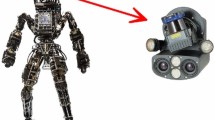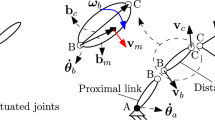Abstract
This paper describes an approach for structural analysis for design improvements of complex, e.g. hybrid, kinematic structures utilizing static and dynamic models. It is suitable to locate improvement potentials in existing mechanisms, facilitate goal-oriented design of new mechanisms or for a simulation-based controller synthesis e.g. a compliance-controller. To receive a model close to reality, mechanical influences, which are commonly neglected in conventional robot models, are analyzed regarding their relevance and if suitable integrated into the model. Investigated effects are the mechanical compliances of links and gears, compliances of the actuators resulting from the control circuits as well as non-linear frictional influences of the actuators. The kinematic and dynamic model is realized as an iterative solution instead of a closed analytic solution with extensive symbolic expressions. This leads to an analysis with clearly arranged aspects, further more the model is suitable for usage in a real-time control. The mechanical influences are analyzed analytically. The derived dynamic modeling is based on the Newton-Euler formulation. The approach is applied to the robotic walking simulator HapticWalker, a device for robot assisted gait rehabilitation. It consists of two identical hybrid parallel-serial manipulators. The forces calculated by the use of the developed model are in a good congruence with measured values. An obviously improved correspondence between measured and calculated values is achieved by the non-linear friction model of the actuators.

















Similar content being viewed by others
References
Schmidt H, Hesse S, Bernhard R, Krüger J (2005) Hapticwalker—a novel haptic foot device. ACM Trans Appl Perception 2:166–180
Ackermann J (1989) Positionsregelung reibungsbehafteter elastischer Industrieroboter. VDI-Verlag, Dsseldorf
De Luca A, Siciliano B (1991) Closed-form dynamic model of planar multilink lightweight robots. IEEE Trans Syst, Man, Cybernetics 21:826–839
Denavit J, Hartenberg R (1955) A kinematic notation for lower pair mechanisms based on matrices. ASME J Appl Mech 77:215–221
Tsai L-W (1999) Robot analysis. Wiley, New York
Merlet J-P (2001) Parallel robots. Kluwer, Dordrecht
Decker K-H (1998) Maschinenelemente. Carl Hanser Verlag, Mnchen
Gomes SCP, Chrétien JP (1992) Dynamic modelling and friction compensation control of a robot manipulator joint. Proceedings of the 1992 IEEE international conference on robotics and automation, pp 1429–1435
Daemi-Avval M (1998) Modellierung und identifikation der dynamik von Industrierobotern für den Einsatz in Regelungen. VDI-Verlag, Dsseldorf
Röhrig C (2003) Zur Lageregelung synchroner Linearmotoren fr hochdynamische Anwendungen unter besonderer Berücksichtigung der Kraftwelligkeit. VDI-Verlag, Dsseldorf
Grotjahn M (2003) Kompensation nicht-linearer dynamischer Effekte bei seriellen und parallelen Robotern zur Erhöhung der Bahngenauigkeit. VDI-Verlag, Düsseldorf
Armstrong-Hélouvry B (1991) Control of Machines with Friction. Kluwer Academic Publishers, Boston
Henrichfreise H (1988) Aktive schwingungsdämpfung an einem elastischen knickarmroboter. Master’s thesis, Universität-GH Paderborn
Gross H, Hamann J, Wiegärtner G (2006) Technik elektrischer Vorschubantriebe in der Fertigungs- und Automatisierungstechnik. Publicis KummunikationsAgentur GmbH, GWA, Erlangen
Daemi M, Heimann B (1996) Identification and compensation of gear friction for modeling of robots. Proc of the 11th CISM-IFToMM symposium on the theory and practice of robots and manipulators, pp 89–96
FAG Wälzlager (1999) Kugellager, Rollenlager, Gehäuse, Zubehr. FAG Industrial Bearings AG
Weck M, Brecher C (2006) Werkzeugmaschinen—mechatronische systeme, vorschubantriebe, prozessdiagnose. Springer, Berlin
Poll G (2007) Mechanische Konstruktionselemente 4—Wälzlager. Dubbel: Taschenbuch für den Maschinenbau, 22. Auflage, pp G 74–G 88
Lackmann J (2007) Festigkeitslehre 2—Beanspruchung stabförmiger Bauteile. Dubbel: Taschenbuch für den Maschinenbau, 22. Auflage, p C 18
Author information
Authors and Affiliations
Corresponding author
Rights and permissions
About this article
Cite this article
Brüning, M., Hussein, S., Schmidt, H. et al. Structural analysis method for optimized design of complex kinematic structures using static and dynamic models and application to a robotic walking simulator. Prod. Eng. Res. Devel. 4, 525–534 (2010). https://doi.org/10.1007/s11740-010-0233-6
Received:
Accepted:
Published:
Issue Date:
DOI: https://doi.org/10.1007/s11740-010-0233-6




